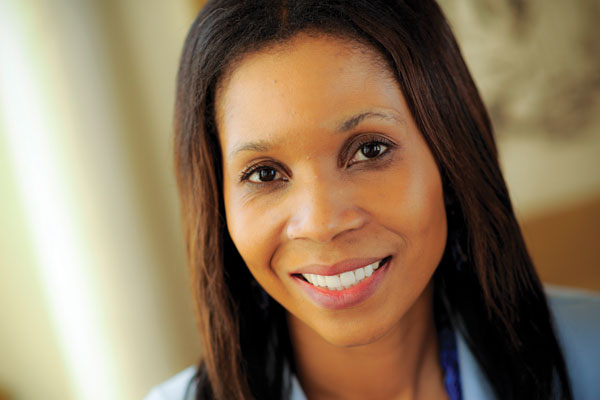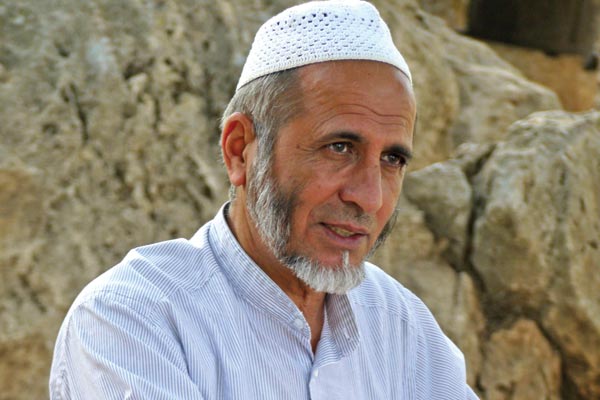The Faces of Diversity
Responding to a need that has never been greater, Nazareth is moving toward a brighter and more inclusive future
by Erich Van Dussen
Nazareth President Daan Braveman recalls a picnic he attended last summer for a range of diverse students, including visiting foreign enrollees in the College’s English Language Institute and incoming first-year students from the Higher Education Opportunity Program.
“At one point, some students from Peru went over and grabbed the students from Brooklyn, got them on the floor, and the students all just started dancing,” he says. “There they were, every color, every religion, every race, and I don’t know how many countries, and they’re all just dancing. It was pretty remarkable.
“I said to my wife, ‘You know, the world could learn a lot from these students.’”
Learning those lessons—how to create a Nazareth community distinguished not only by a truly diverse population, but also by an inclusive spirit that allows all backgrounds to flourish—has become an increasingly hot topic at the College in recent years. And while everyone involved in this ongoing task acknowledges that the journey has only just begun, the enthusiasm behind the effort is heating up as well.
“Why is diversity important?”
The answer to that question, says Nazareth President Daan Braveman, couldn’t be simpler: “It enriches and adds value to the college experience in every way.”
Although the world has always had diverse cultures, he explains, technological advances of the last quarter-century have pushed those cultures to interact to an unprecedented degree. “Diversity is all around us, live and in person—and it is critical that we provide our students the understanding and skills to work with people who are different than they are, to understand what one author calls the ‘dignity of difference.’ We have an absolute obligation to do this.”
For all these reasons, the decision to add specific goals on diversity to the College’s 2020 Strategic Plan—a foundational document guiding Nazareth’s direction into the next decade—was an easy one.
“It’s the right thing to do, in terms of providing more access and more opportunities for students from very different perspectives, with different value systems and different ethnicities and religious backgrounds,” says Ian Mortimer, vice president for enrollment management. “And it’s also better for the College. The more diverse we become, the better our ability to attract the best and the brightest students from all walks of life—the future of this country.”
Building a diverse campus
Horace Smith, Ph.D., works literally next door to President Braveman, sending a clear signal that the office of Special Assistant to the President on Diversity Issues is a strategic priority at Nazareth.
Smith left his role as associate vice president for academic affairs in late 2013, when Braveman responded favorably to his position paper that articulated a vision for the then-theoretical office. “He told me, ‘That’s precisely what we want to do’,” he recalls. “The president has an amazing passion for the goal of building a more diverse and representative campus.”
One of Smith’s current responsibilities is coordinating the rollout of the Young Scholars Program, which has formed initial partnerships with four high schools in this region and downstate New York. Inspired in part by an existing relationship between Nazareth and Brooklyn’s Medgar Evers School, the program forms pre-enrollment relationships with high school seniors identified as having particular potential for collegiate success. Special senior-year coursework and academic counseling give the inner-city students a college-prep experience more common to affluent suburban school districts.
“We want to create an environment for students who enroll in this project that will increase the probability of their success and establish an expectation that provides a model for all our students,” Smith says.
Those priorities are shared in other well-established diversity programs at Nazareth. For instance, Khalil Williams ’18 cites the Summer Start program for incoming HEOP/Excel students as helping him acclimate quickly to his college life. (The Higher Education Opportunity Program, or HEOP, provides academic support and Excel financial assistance to students from socioeconomically challenged backgrounds.)
Williams hails from Amherst, NY, where the predominantly white population of his high school led him to view Nazareth as comparatively progressive. “Although Nazareth may be a mostly white college to some people, in reality it has so much diversity, ideas, and types of people,” he says. “I’ve had the chance to meet students from around the world and develop new friendships with people I never thought I’d be able to relate to.”
Minority enrollment at Nazareth has climbed steadily in the last decade among undergraduate and graduate students alike, from 9.4 percent in 2005 to 16.1 percent in the 2013-2014 academic year. Yomayra Guerrero ’16 has noticed that trend: “During my freshman year, the only people of color … I encountered were from the HEOP/Excel Program and maybe a handful of staff and faculty,” she says, but since then “I have seen an abundance of diversity from all races and ethnic backgrounds.”
Guerrero does note a relative lack of diversity of faculty and staff—an inequity that is acknowledged by Nazareth administration. “We need to do a much better job” in that area, President Braveman says. “We’ve seen improvements over the years, but it’s still something we have to work on.” Department chairs and Nazareth’s Human Resources team are all committed to broadening applicant pools to ensure the recruitment of talented professionals from diverse backgrounds whenever possible.
Brian Bailey, Ph.D., associate professor of education and director of the Center for Service Learning, would like to see those efforts extend to aggressive minority recruitment of Nazareth faculty and administrators, as well as on the College’s Board of Trustees. “The diversity of our student population has seen a marked improvement in the six years I’ve been here, but if you look at our faculty and the highest levels of decision-makers at the College, there’s a long, long way to go,” he says.
The inclusivity challenge
If there is a risk in embracing diversity for its own sake, it’s this: What if you’re successful in attracting disparate groups to campus—only to find they don’t feel at home?
“All forms of diversity are very important to our future,” says Mortimer. “But just because it’s a diverse place doesn’t mean all of your students, or your faculty and staff, actually feel included. If that inclusion doesn't happen, you really haven’t succeeded at what a College should be.”
Nazareth’s Institute for Pluralism was founded a year ago to help address that issue. Its director, Shirley Sommers, Ph.D., was already acutely aware of the need for such a program: As a veteran faculty member and a South African native, she had been subjected in the past to instances of benign prejudice—for example, when a well-intentioned student assumes a person of color doesn’t know their way around campus, and offers unsolicited directions.
“People tell themselves, ‘I’m not biased or prejudiced. Would I be a college professor, or a college student, if I were?’” she says. “But the unconscious unawareness of our prejudices can create a dangerous risk. We all have prejudices, and when we presume that we are okay—when you tell yourself that you don’t need improvement—it makes real change very difficult to achieve.”
Part of Sommers’ job involves offering support for student reports of “micro-aggressions”—often comparatively minor offenses that are more reflective of insensitivity than malice. No matter the underlying cause, however, the effects on their targets can be devastating to morale and self-esteem.
As a Muslim faculty member, Muhammad Shafiq, Ph.D., recognizes the potential for faculty and staff from diverse backgrounds to feel marginalized. “It is not my personal experience, however,” he says. “I think the people of Nazareth are well aware of the importance of diversity, and being respectful.”
Sommers says she hasn’t encountered many concerns that touch on religious bias—but instead of adopting a no-news-is-good-news stance, she’s obligated to consider whether the absence of complaints masks a more subtle issue. “Sometimes silence just represents a different form of marginalization,” she says. “People might feel they can’t really speak out, because they’re not comfortable and feel that their voices will not be heard.”
International students can face more subtle challenges, including an intimidation factor that can begin before they even set foot on campus. Janna Jamso ’17, a women and gender studies major from Bhutan, says she first learned about American culture from movies—and didn’t know what to expect when she first came to Nazareth. “I thought that Americans would be very rude, but they aren’t,” she says. “I did have trouble making friends at first, but that is because I’m really shy. You have to be willing to break the ice if you want to adjust and be happy.”
She sees a lack of confidence among international students that can keep them from making friends outside of their sharply identified social groups. In classes, that same phenomenon can result in a student being reluctant to engage. “There is a lack of confidence—sometimes it’s like they feel they are not smart enough. Unless they’re asked a question, they won’t speak up.”
Recent wins, and the road ahead
If the occasional potholes have been unavoidable on Nazareth’s road to diversity, the trip to date has yielded many assorted positive milestones as well. In addition to the increasing diversity enrollment statistics, for instance, the recent introduction of gender-neutral restrooms in key public areas on campus—accommodating transgender students, faculty, and staff—has been “a wonderful development,” Sommers says.
Alexander Ives ’15G agrees, and praises the College’s inclusive policies towards transgender students. As an intern temporarily in charge of the newly formed LGBTQ Advocacy and Education program—a sub-initiative of the Pluralism Institute—his responsibilities include maintaining a watchful eye over the interests of one of the least visible minority groups on any college campus.
“If transgender students notify the residence life office, they can live in the residence halls in accordance with their expressed gender, and have private showers and bathrooms. That’s a big deal,” he says. “But if they don’t openly self-identify, they can go completely unknown on campus—and not receive any of the support that could help them. That’s why it’s so important that we create a climate that makes them feel welcome, and safe.”
Another major effort now underway is the planning to conduct a campus-wide climate survey in Spring 2015, to probe the state of interactions between Nazareth’s faculty, staff, and students.
“It’s been a long time since we’ve had that kind of comprehensive assessment,” says Kevin Worthen, vice president for student development. “Anecdotal reports are always valuable, but I know we can’t wait to have nationally normed data that tells us not only how our people feel, but also how those feelings compare to other colleges.” That data, Worthen adds, will aid in prioritizing the diversity components of the 2020 Strategic Plan.
Until then, Nazareth will continue on the road toward a more diverse and inclusive future—with ongoing reminders apparent everywhere of the potential benefits of success.
Erich Van Dussen is a freelance writer in Rochester, New York.

Shirley Sommers, Ph.D., director of Nazareth's Institute for Pluralism

Muhammad Shafiq, Ph.D., director of the Hickey Center for Interfaith Studies and Dialogue
Diversity Initiatives
Nazareth's ongoing pursuit of a diverse and inclusive campus culture requires the involvement of all areas of the College community.
Note: The Institute for Pluralism was renamed to the Office for Diversity & Inclusion in 2016.